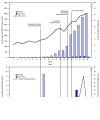Detection and Genetic Characterization of Community-Based SARS-CoV-2 Infections - New York City, March 2020
- PMID: 32678072
- PMCID: PMC7366849
- DOI: 10.15585/mmwr.mm6928a5
Detection and Genetic Characterization of Community-Based SARS-CoV-2 Infections - New York City, March 2020
Abstract
To limit introduction of SARS-CoV-2, the virus that causes coronavirus disease 2019 (COVID-19), the United States restricted travel from China on February 2, 2020, and from Europe on March 13. To determine whether local transmission of SARS-CoV-2 could be detected, the New York City (NYC) Department of Health and Mental Hygiene (DOHMH) conducted deidentified sentinel surveillance at six NYC hospital emergency departments (EDs) during March 1-20. On March 8, while testing availability for SARS-CoV-2 was still limited, DOHMH announced sustained community transmission of SARS-CoV-2 (1). At this time, twenty-six NYC residents had confirmed COVID-19, and ED visits for influenza-like illness* increased, despite decreased influenza virus circulation.† The following week, on March 15, when only seven of the 56 (13%) patients with known exposure histories had exposure outside of NYC, the level of community SARS-CoV-2 transmission status was elevated from sustained community transmission to widespread community transmission (2). Through sentinel surveillance during March 1-20, DOHMH collected 544 specimens from patients with influenza-like symptoms (ILS)§ who had negative test results for influenza and, in some instances, other respiratory pathogens.¶ All 544 specimens were tested for SARS-CoV-2 at CDC; 36 (6.6%) tested positive. Using genetic sequencing, CDC determined that the sequences of most SARS-CoV-2-positive specimens resembled those circulating in Europe, suggesting probable introductions of SARS-CoV-2 from Europe, from other U.S. locations, and local introductions from within New York. These findings demonstrate that partnering with health care facilities and developing the systems needed for rapid implementation of sentinel surveillance, coupled with capacity for genetic sequencing before an outbreak, can help inform timely containment and mitigation strategies.
Conflict of interest statement
All authors have completed and submitted the International Committee of Medical Journal Editors form for disclosure of potential conflicts of interest. Wendy Szymczak reports personal fees from Qiagen, outside the submitted work. Lars Westblade reports grants from Accelerate Diagnostics, Inc., Affinity Biosensors, LLC, BioFire Diagnostics, LLC, and Hardy Diagnostics; grants and personal fees from Roche Molecular Systems, Inc.; and personal fees from Shionogi, Inc. No other potential conflicts of interest were disclosed.
Figures

References
-
- Daskalakis D. Health alert #4: COVID-19 updates for New York City. New York, New York: New York City Health; 2020. https://www1.nyc.gov/assets/doh/downloads/pdf/han/alert/2020/covid-19-up...
-
- Daskalakis D. Health alerts #6: COVID-19 updates for New York City. New York, New York: New York Health; 2020. https://www1.nyc.gov/assets/doh/downloads/pdf/han/alert/2020/covid-19-03...
MeSH terms
LinkOut - more resources
Full Text Sources
Miscellaneous

